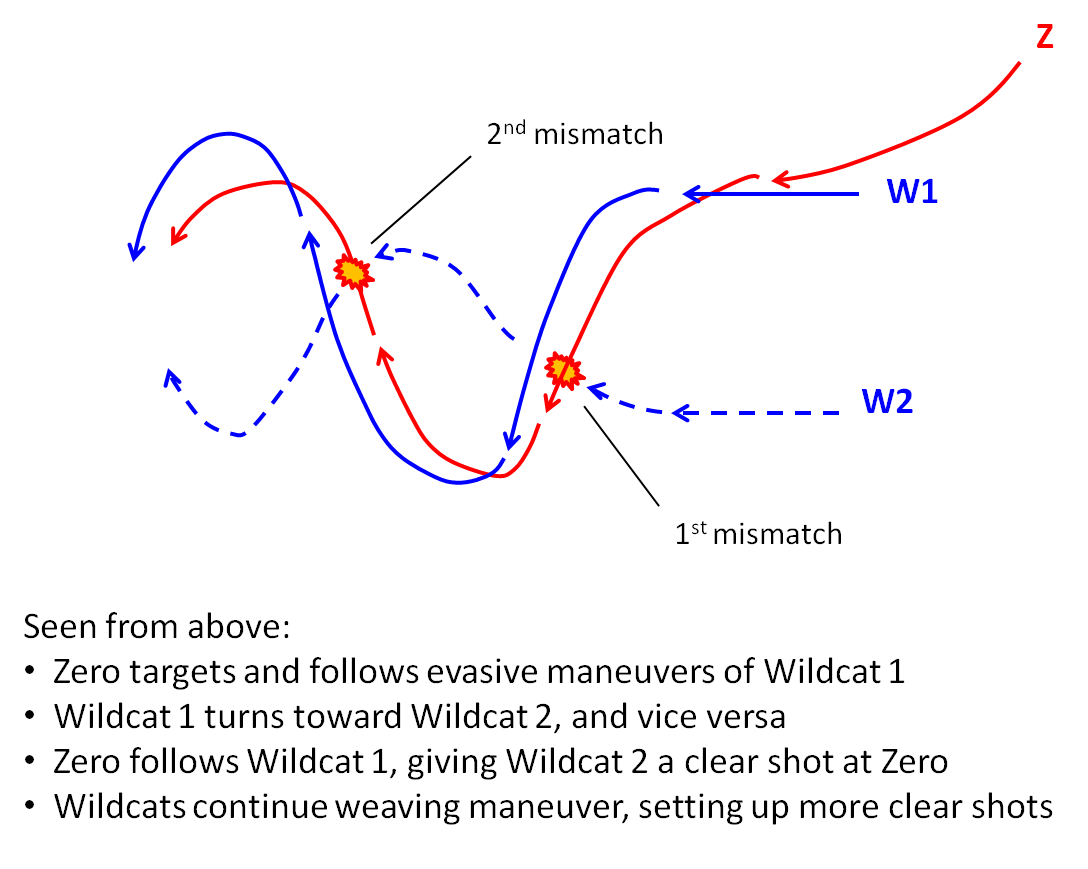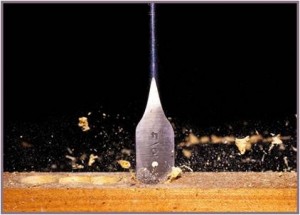Trick question
Question 1: What do successful strategies for drilling a board, catching a pass and winning a dogfight have in common? Answer: a mismatch between an advantage and a vulnerability.
Question 2: In what way is Question 1 a trick question?
Answer: because at bottom all successful strategies are based on a mismatch – it has nothing to do with the specifics of the 3 examples.
And that’s the point.
To have a successful strategy of any kind, you have to arrange for a mismatch that will result in getting to your objective.
And what is a mismatch? It’s a disparity in some characteristic. It can be any sort of characteristic, obvious or non-obvious. Let’s look at some different kinds.
Catching a pass
Finding a mismatch is a preoccupation in American football. A coach and his assistants are constantly looking for situations in which some advantage on their part can be successfully matched up against some vulnerability of their opponent’s. A really quick lineman against a slower opponent. An agile runner against a bigger tackler.
The design of a play is based on creating mismatches. A pass receiver may normally be covered by a taller defender, but if he runs a slanting route into the zone of a shorter or slower defender, the quarterback may be able to hit him with a pass at the moment of mismatch. An offensive coordinator, often sitting high in a stadium booth above the action, is watching for such opportunities and communicating these mismatches down to the coaches.
Meanwhile, the opposing team’s defensive coordinator, also often sitting high above the action, is solving the puzzles of how to obviate them; and is also looking for mismatches that his defenders can exploit. In NFL football games there is a constant, dynamic battle of finding and exploiting favorable mismatches and hiding, reducing or eliminating unfavorable ones.
On the surface we may see a decisive tackle or beautiful pass. But underneath, the success of the action was based on finding or creating a mismatch. Without the mismatch, that pass – no matter how beautiful – may well have gone right into the arms of a defender.
Making a hole
Here’s a really simple example. Even something as mundane as making a hole in a board is based on a mismatch. The material where you’d like to have a hole is the barrier. You can get through that barrier in various ways, based on the vulnerabilities of that material, and the advantages you have in your resources.
Wood burns, destroying it’s resistance to penetration, so you can heat up a poker, if you have one, and burn the hole you need. Some acids can destroy the integrity of the wood, so you can employ a bit of chemical warfare. Or you can use a small explosive charge to blast your way through. Or you can shoot through it with a gun. Or hammer a nail through it and then remove the nail. Or place the mouth of a jar of termites on the board.
If all else fails, you could try using a drill.
In all these cases, the board barrier was some physical thing you had to get through. So the mismatch characteristic was hardness – the ability to resist penetration. All the above penetration exploits were focused on arranging for mismatches in that characteristic.
But the barriers we face are not all physical. They can be mental, social, political, financial, bureaucratic, etc. They can be system effects.
Whatever kind of barrier we may be dealing with, an initial look at a situation may seem hopeless. But imagining or finding arrangements producing favorable mismatches may well turn that around. Here’s an example.
Thatch Weave
There was a period during the Pacific campaign of WWII in which the U.S. Navy pilots were flying fighter planes that had many disadvantages and very few advantages, compared with their Japanese counterparts. The Japanese Zeros had higher acceleration, speed and rate of climb. They had a smaller turning radius and generally greater maneuverability.
The American Wildcat fighter had more armor protecting the pilot and fuel tanks and could generally take more of a pounding than the Zero. But overall, these mismatches amounted to a losing equation for the American pilots during a dogfight. It was relatively easy for a Japanese pilot to maneuver in behind a Wildcat and pump it full of bullets. An ugly situation.
What to do? Before leaving the U.S. for the Pacific, a fighter pilot / Squadron Commander (eventually Admiral) named John Thatch thought long and hard about the lethal mismatches he and his squadron would be up against, and came up with a new one of his own, that turned the tables on his Japanese adversaries.
He would use the Wildcats in pairs. Always pairs. When a Zero got on the tail of a  Wildcat, the Wildcat pair would immediately begin a pattern in which they would turn toward each other’s flight path and then start weaving back and forth, crossing paths (see blue lines in diagram). The Zero (red line), locked onto its tightly turning intended victim, quickly becomes completely exposed to the direct fire of the 2nd Wildcat, while neither Wildcat gets seriously exposed to the Zero’s fire.
Wildcat, the Wildcat pair would immediately begin a pattern in which they would turn toward each other’s flight path and then start weaving back and forth, crossing paths (see blue lines in diagram). The Zero (red line), locked onto its tightly turning intended victim, quickly becomes completely exposed to the direct fire of the 2nd Wildcat, while neither Wildcat gets seriously exposed to the Zero’s fire.
Executing this strategy became a critical part of a Wildcat pilot’s survival skills.
Thatch’s strategy creates a string of completely favorable mismatches (full Wildcat firepower vs. zero Zero firepower) that nullifies the Zero’s considerable advantages, until the Zero is either shot out of the sky or breaks off his attack. Strategy prevailed and the Thatch Weave, as it came to be known, changed the balance of the Pacific air war and continued to be used even into the Vietnam era in poor mismatch situations.
The key was finding a way to arrange for a favorable mismatch even when perceived barriers and mismatches appeared hopelessly unfavorable.
_______________________________
Readers are encouraged to add comments to this post.
And if you’d like to share or recommend this post, click on your preferred way in the left margin sidebar.
Up next, a post on key outside factors affecting the outcomes of strategies – Creative Thinking and the Destruction of a Game: External Strategy Factors.
If you’re not currently being automatically notified when new posts are published, then please Follow Real Strategy (top of right hand column on this page), and indicate how you’d prefer to be notified.
For other posts of interest, look in the Smart Menu.
Photo credit: Drill Bit 4, Board 0, Photo by Charles Knowles of The Knowles
Gallery: www.flickr.com/photos/theknowlesgallery/5776650452







The way you have presented strategy makes so much sense because (besides the excellent presentation) it evokes the universally understood patterns of journey, war, and games. These patterns or metaphors have basic elements that almost everyone immediately grasps. And these three patterns share some elements, but not all. For example, all three contain the basic journey pattern of start, path (with or without obstacles or barriers), and destination (objective). War and games share ideas of territories or possessions that can be captured, defended, lost. Only the games pattern strongly invokes the notions of rules and turn-taking. Mismatch has to do with understanding the rules and then creatively breaking them (including moving out of turn).
[Translate]
I’m still thinking about this. Let’s connect on it sometime.
[Translate]